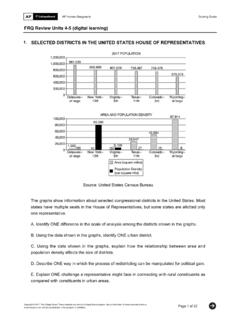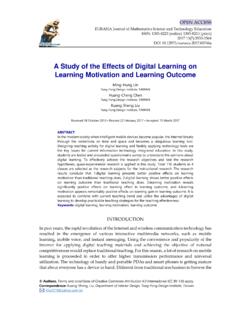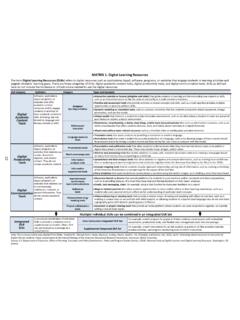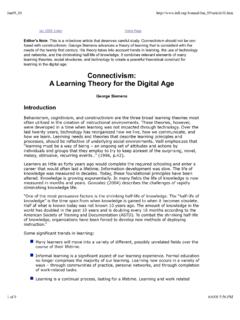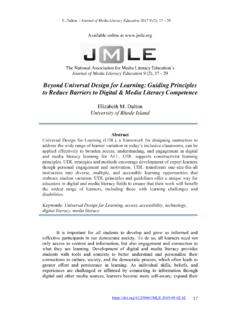Transcription of Unit 3 FRQ Practice (Digital Learning)
1 AP Human GeographyScoring GuideUnit 3 FRQ Practice ( digital learning ) Copyright 2017. The College Board. These materials are part of a College Board program. Use or distribution of these materials online orin print beyond your school s participation in the program is 1 of : UNESCOThe graphs show the current status of indigenous languages in the Americas and Africa astracked since 1970. Vulnerable languages have a decreasing population that speaks thelanguage. Endangered languages have a small number of speakers who are limited to smallcommunities. Critically endangered languages have only a small community of speakers the term indigenous language. the types of physical regions where indigenous languages are most likely how historically the political geography of colonialism affected how indigenous languages have been under threat from primary in the Americas since the the degree to which globalization can explain the loss of indigenous languages since the the data in the two graphs and explain why indigenous languages are in Africa than in the data in the graphs, explain how media and communications technology can to preserve indigenous languages in the Americas.
2 Please respond on separate paper, following directions from your AOne point for a correct definitionAP Human GeographyScoring GuideUnit 3 FRQ Practice ( digital learning ) Copyright 2017. The College Board. These materials are part of a College Board program. Use or distribution of these materials online orin print beyond your school s participation in the program is 2 of 17 01 The response correctly defines the term indigenous language by using ONE of the following: An indigenous language is a language that is spoken by the original, aboriginal, first, first nation, native,ethnic, or island inhabitants of a place, area, or region. An indigenous language is a language of inhabitants whose territory has been colonized by anotherculture BOne point for a correct description 01 The response correctly describes types of physical regions where indigenous languages are most likely tosurvive as remote or disconnected areas including TWO or more of the following types of region.
3 Forest polar mountain valley island jungle plateau savannaAP Human GeographyScoring GuideUnit 3 FRQ Practice ( digital learning ) Copyright 2017. The College Board. These materials are part of a College Board program. Use or distribution of these materials online orin print beyond your school s participation in the program is 3 of 17 Part COne point for a correct description 01 The response correctly describes how historically the political geography of colonialism affectedindigenous languages using ONE of the following: Colonist language marginalizes indigenous language. Colonial power favors one indigenous language or group over another within the colony. Legacy of colonial education systems deemphasize learning in indigenous language or context.
4 Business and trade favors colonist language or the development of pidgin or creole languages. State religious institutions impose colonist languages or translate colonist religious texts into DOne point for a correct explanation 01 The response correctly explains how indigenous languages have been under threat from primaryeconomic activities in the Americas since the 1970s by using ONE of the following:Extractive industries (oil, natural gas, hydroelectric dams, forestry, mining, commercial fishing,aquiculture, agribusiness) are appropriating land and resources from indigenous peoples. And the answershould include one of the following: Extractive industries are causing indigenous peoples to migrate, disperse, or otherwise lose theirAP Human GeographyScoring GuideUnit 3 FRQ Practice ( digital learning ) Copyright 2017.
5 The College Board. These materials are part of a College Board program. Use or distribution of these materials online orin print beyond your school s participation in the program is 4 of 17connection to their land and culture. Extractive industries are interrupting local indigenous community life or breaking-up indigenous socialnetworks. Extractive industries are introducing workers from the outside who bring non-native language andculture or employ local indigenous people who assimilate to non-native language and EOne point for a correct explanation 01 The response correctly explains the degree to which globalization can explain the loss of indigenouslanguages in Africa since the 1970s, using ONE of the following:There is less use or less need for indigenous languages due to one of the following processes: Media, Internet, consumer goods, trade, and higher education encourage indigenous peoples to learn,accept, or adapt to the global economy or globalized culture.
6 Foreign investment in infrastructure ( , cellular phone networks, railways, highways, and ports) placesindigenous peoples in contact with the global economy or globalized culture. Nongovernmental organizations (NGOs) and aid agencies create local institutions where non-nativelanguages are FOne point for a correct explanationAs a comparison, the response must include a statement regarding Africa AND a statement regarding Human GeographyScoring GuideUnit 3 FRQ Practice ( digital learning ) Copyright 2017. The College Board. These materials are part of a College Board program. Use or distribution of these materials online orin print beyond your school s participation in the program is 5 of 17 01 The response correctly explains why indigenous languages are less threatened in Africa than in theAmericas, by using ONE of the following comparisons: In Africa, there is better support from local government, community and cultural groups, whereas in theAmericas, fewer public and private institutions support indigenous language use.
7 In Africa, education, trade, employment, and shopping can be transacted in indigenous languages or ina lingua franca. In the Americas, basic and daily activities most commonly take place in the language ofthe dominant culture. In Africa, there are more rural, agricultural societies in which indigenous languages may flourish. In theAmericas, a larger percent of the population lives in urban regions where indigenous languages might notbe accepted. In the Americas many indigenous populations have been negatively affected by disease andresettlement, which has interrupted the resilience and longevity of indigenous languages. In Africa,immunity to Old World diseases and the ability to maintain local indigenous social networks has resultedin the endurance of local languages and cultural GOne point for a correct explanation 01 The response correctly explain how media and communications technology can be used to preserveindigenous languages in the Americas, by using ONE of the following:The large percentage of languages under threat in the Americas can benefit from one of the following toimprove chances of survival.
8 Translation of religious, musical, historical, or other cultural traditions into script are created for writtenAP Human GeographyScoring GuideUnit 3 FRQ Practice ( digital learning ) Copyright 2017. The College Board. These materials are part of a College Board program. Use or distribution of these materials online orin print beyond your school s participation in the program is 6 of 17languages that were formerly oral or from spoken-word societies. The development of written, printed, or typed indigenous languages, using native terms to describeflora, fauna, foods, medicines, traditions, and toponyms have proliferated in scientific, print, radio,television, and digital media, expanding the use of indigenous languages to even nonspeakers. Culturally specific ways of observing or interacting with the environment (agricultural practices, animalhusbandry, land use, systems of property, animist religious traditions, rites of passage, resource use,trade in natural resources, engineering, navigation, and astronomy) have been brought to the attention ofscientific, educational, governmental, and non-governmental organizations, who develop media,documents, courses, and textbooks that help to preserve indigenous language and culture.
9 Social media platforms integrate indigenous languages into their software to allow for interaction acrosselectronic media and devices. Installation of rural cellular telephone, cellular data networks, and/or satellite communication systemsallow for indigenous peoples to improve communication between communities in different : You have 25 minutes to answer the following question. It is suggested that youtake up to 5 minutes of this time to plan and outline each answer. While a formal essay is notrequired, it is not enough to answer a question by merely listing facts. Illustrate your answerswith substantive geographic examples where Human GeographyScoring GuideUnit 3 FRQ Practice ( digital learning ) Copyright 2017. The College Board. These materials are part of a College Board program.
10 Use or distribution of these materials online orin print beyond your school s participation in the program is 7 of 17 The viability of any state depends on a balance between centripetal and centrifugal Define the concepts centripetal force and centrifugal force. B. Give a specific example of and explain a centripetal force that affects the viability of any ofthe states shown on the map With reference to a different specific example, explain a centrifugal force that affects theviability of any of the states shown on the map above. Please respond on separate paper, following directions from your A(2 points)Define the concepts centripetal force and centrifugal force. 1 point:Generalized definition of centripetal and centrifugal without explicit reference to viability of a state ORAP Human GeographyScoring GuideUnit 3 FRQ Practice ( digital learning ) Copyright 2017.
